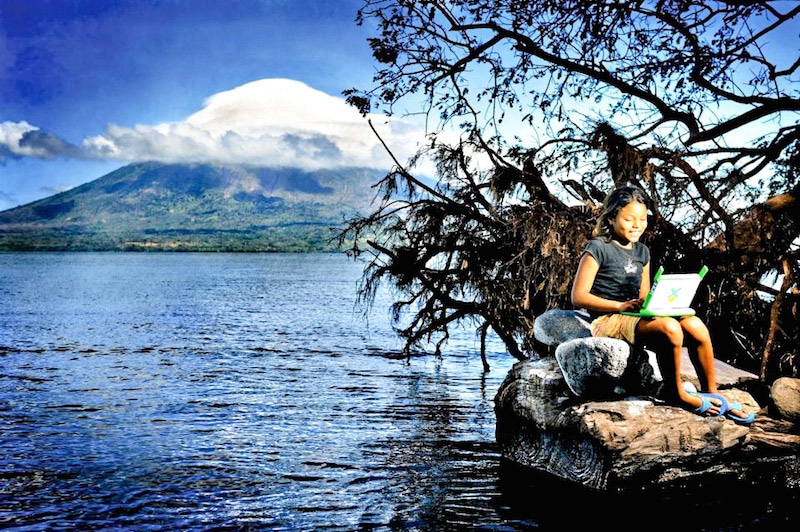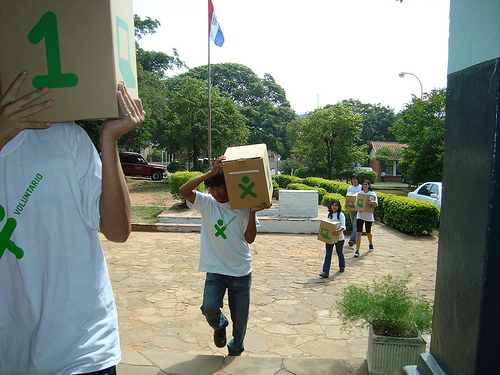Ometepe, Nicaragua is a legendary and extraordinary place: a double-volcano island that has maintained its community and culture fairly distinct from the country around them. Daniel Drake and others have been helping them realize Nicaragua’s latest deployment (past coverage), thanks to the ongoing work of Fundación Zamora Teran, connecting every child on the island to the Internet and to eachother. After its public launch last week, Rodrigo shared this beautiful and inspiring report from the island (pdf).
En el corazón de Nicaragua, y en medio del lago del mismo nombre, el lago más grande de América Latina, millones de años atrás una erupción volcánica formó una curiosa isla compuesta por dos volcanes, uno de ellos activo aún. El nombre indÃgena, Ometepe, significa precisamente dos montañas. Con 245 km2, constituye la isla de agua dulce más grande de las Américas. Declarada como una de las maravillas naturales del mundo por la ONU, ciertamente posee cierto aire paradisÃaco, tropical, exuberante, mágico, como un set de pelÃcula. Sus 50,000 habitantes, indÃgenas en un 90%, vivieron hasta hace menos de una generación en un oscurantismo medieval, una especie de parque jurásico, donde ningún habitante sabÃa leer o escribir. El dÃa de ayer, en un espectacular y malabárico salto de la rana, Ometepe se convirtió de repente en la primera isla de las Américas totalmente digital, donde el 100% de sus 5,000 niños de escuela primaria y la totalidad de sus docentes, recibieron uno de nuestros laptops XO, conectado al Internet de alta velocidad y con las aplicaciones pedagógicas inherentes.
Llegamos a Ometepe acompañando una comitiva de empresarios no solo de Nicaragua sino de todo Centro América y de representantes de organismos multilaterales, ONGs, medios de comunicación internacionales y funcionarios del gobierno, interesados todos en ver por si mismos lo que la fundación Zamora Teran viene haciendo en Nicaragua.
Fundada por el banquero Roberto Zamora y por su esposa Maria Josefina Teran, han logrado en menos de 30 meses una transformación educacional y al mismo tiempo una buena aplicación del concepto de filantropÃa transformadora, sin precedentes. De su propio bolsillo y con aportaciones recientes de clientes, personas naturales y hasta de un paÃs, Dinamarca, han logrado ya entregar 28,000 laptops en varias regiones de critica pobreza en este paÃs, de por si uno de los más pobres de las américas. Como si fuera poco, anunciaron que aspiran a implementar 500,000 unidades, es decir el 100% de los niños de primaria de Nicaragua, incluyendo discapacitados mentales (autismo, sÃndrome de Dawn), discapacitados visuales o fÃsicos (ver foto) antes del 2015! Al ver lo que han logrado en estos 30 meses, no me queda la menor duda de que lo lograrán.

Para llegar a la isla hay que tomar primero un bus por más de dos horas hasta llegar a uno de los varios puertos en las riberas del lago. Luego, un Ferry que tiene varias frecuencias de viaje por dÃa, se tarda otras dos horas para llegar al puerto de Ometepe. Desde la distancia, se vislumbran las siluetas de los dos volcanes como guardianes de un ecosistema de exuberancia tropical que necesita cariñosa vigilancia. Carreteras adoquinadas evocan épocas pasadas y al mismo tiempo entrevén aplicaciones prácticas de adaptación a los continuos movimientos telúricos. Los adoquines son más flexibles y se acomodan ejerciendo una labor de amortiguación cuando la madre tierra manifiesta su vitalidad y fortaleza con unos terremotos como el de 1972 que destruyó Managua. Tierra fértil por ser conformada por cenizas volcánicas, la agricultura y el turismo constituyen las principales fuentes de ingresos de sus habitantes. El clima es un poco más benigno que el de Managua, conocida por su calor asfixiante, pues las laderas de los dos volcanes producen corrientes de aire que refrescan un poco el ambiente.
La paradoja consiste en que los niños de esta población estarÃan marcados a seguir la suerte de sus ancestros, agricultores artesanales de pequeños minifundios con costumbres milenarias pre-colombinas pero que precisamente dichas culturas estarÃan en vÃas de extinción por pura inercia. El traer estas culturas a la modernidad, lejos de acabar con ellas, ofrece una oportunidad de poderlas difundir y compartir, como ya estamos haciendo con casos similares en Mexico y Perú.
Convencidos de que la única solución a ese circulo vicioso destructivo es la educación, el matrimonio Zamora Teran decidió embarcarse en esta misión de rescate de las juventudes Nicaraguenses para lo cual adoptaron el proyecto One Laptop Per Child como vehÃculo de cambio educacional y de inclusión social y económica.
Meses de preparación previa con los docentes, padres de familia y algunos estudiantes claves, garantizan que inmediatamente recibidos estos laptops podrán comenzar a producir el cambio de paradigma educativo y social buscados.
Varios conceptos básicos hacen esto posible… Continue reading →






